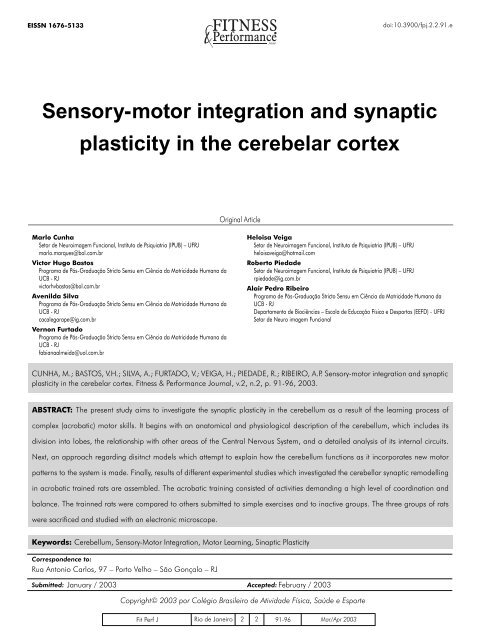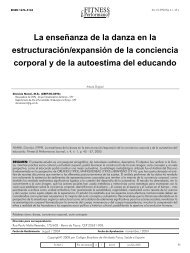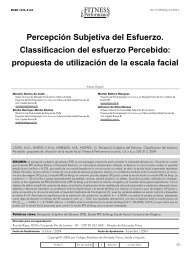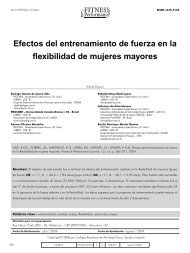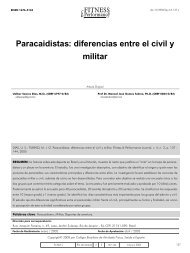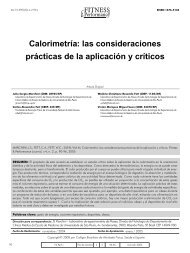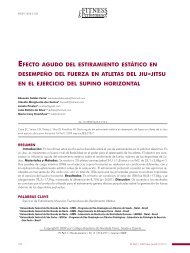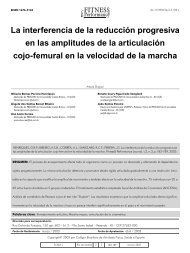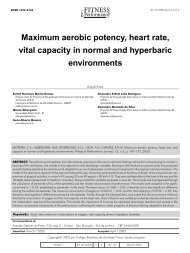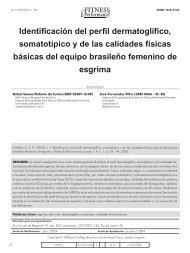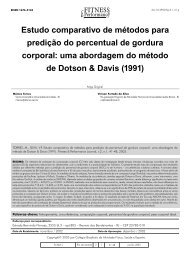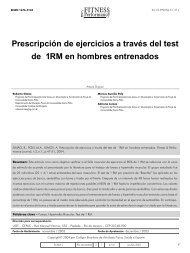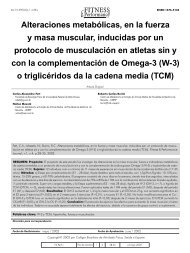Sensory-motor integration and synaptic plasticity in the cerebelar ...
Sensory-motor integration and synaptic plasticity in the cerebelar ...
Sensory-motor integration and synaptic plasticity in the cerebelar ...
Create successful ePaper yourself
Turn your PDF publications into a flip-book with our unique Google optimized e-Paper software.
EISSN 1676-5133<br />
doi:10.3900/fpj.2.2.91.e<br />
<strong>Sensory</strong>-<strong>motor</strong> <strong><strong>in</strong>tegration</strong> <strong>and</strong> <strong>synaptic</strong><br />
<strong>plasticity</strong> <strong>in</strong> <strong>the</strong> <strong>cerebelar</strong> cortex<br />
Orig<strong>in</strong>al Article<br />
Marlo Cunha<br />
Setor de Neuroimagem Funcional, Instituto de Psiquiatria (IPUB) – UFRJ<br />
marlo.marques@bol.com.br<br />
Victor Hugo Bastos<br />
Programa de Pós-Graduação Stricto Sensu em Ciência da Motricidade Humana da<br />
UCB - RJ<br />
victorhvbastos@bol.com.br<br />
Avenilda Silva<br />
Programa de Pós-Graduação Stricto Sensu em Ciência da Motricidade Humana da<br />
UCB - RJ<br />
cacalegarape@ig.com.br<br />
Vernon Furtado<br />
Programa de Pós-Graduação Stricto Sensu em Ciência da Motricidade Humana da<br />
UCB - RJ<br />
fabianaalmeida@uol.com.br<br />
Heloisa Veiga<br />
Setor de Neuroimagem Funcional, Instituto de Psiquiatria (IPUB) – UFRJ<br />
heloisaveiga@hotmail.com<br />
Roberto Piedade<br />
Setor de Neuroimagem Funcional, Instituto de Psiquiatria (IPUB) – UFRJ<br />
rpiedade@ig.com.br<br />
Alair Pedro Ribeiro<br />
Programa de Pós-Graduação Stricto Sensu em Ciência da Motricidade Humana da<br />
UCB - RJ<br />
Departamento de Biociências – Escola de Educação Física e Desportos (EEFD) - UFRJ<br />
Setor de Neuro imagem Funcional<br />
CUNHA, M.; BASTOS, V.H.; SILVA, A.; FURTADO, V.; VEIGA, H.; PIEDADE, R.; RIBEIRO, A.P. <strong>Sensory</strong>-<strong>motor</strong> <strong><strong>in</strong>tegration</strong> <strong>and</strong> <strong>synaptic</strong><br />
<strong>plasticity</strong> <strong>in</strong> <strong>the</strong> <strong>cerebelar</strong> cortex. Fitness & Performance Journal, v.2, n.2, p. 91-96, 2003.<br />
ABSTRACT: The present study aims to <strong>in</strong>vestigate <strong>the</strong> <strong>synaptic</strong> <strong>plasticity</strong> <strong>in</strong> <strong>the</strong> cerebellum as a result of <strong>the</strong> learn<strong>in</strong>g process of<br />
complex (acrobatic) <strong>motor</strong> skills. It beg<strong>in</strong>s with an anatomical <strong>and</strong> physiological description of <strong>the</strong> cerebellum, which <strong>in</strong>cludes its<br />
division <strong>in</strong>to lobes, <strong>the</strong> relationship with o<strong>the</strong>r areas of <strong>the</strong> Central Nervous System, <strong>and</strong> a detailed analysis of its <strong>in</strong>ternal circuits.<br />
Next, an approach regard<strong>in</strong>g disitnct models which attempt to expla<strong>in</strong> how <strong>the</strong> cerebellum functions as it <strong>in</strong>corporates new <strong>motor</strong><br />
patterns to <strong>the</strong> system is made. F<strong>in</strong>ally, results of different experimental studies which <strong>in</strong>vestigated <strong>the</strong> cerebellar <strong>synaptic</strong> remodell<strong>in</strong>g<br />
<strong>in</strong> acrobatic tra<strong>in</strong>ed rats are assembled. The acrobatic tra<strong>in</strong><strong>in</strong>g consisted of activities dem<strong>and</strong><strong>in</strong>g a high level of coord<strong>in</strong>ation <strong>and</strong><br />
balance. The tra<strong>in</strong>ned rats were compared to o<strong>the</strong>rs submitted to simple exercises <strong>and</strong> to <strong>in</strong>active groups. The three groups of rats<br />
were sacrifi ced <strong>and</strong> studied with an electronic microscope.<br />
Keywords: Cerebellum, <strong>Sensory</strong>-Motor Integration, Motor Learn<strong>in</strong>g, S<strong>in</strong>aptic Plasticity<br />
Correspondence to:<br />
Rua Antonio Carlos, 97 – Porto Velho – São Gonçalo – RJ<br />
Submitted:<br />
January / 2003 Accepted: February / 2003<br />
Copyright© 2003 por Colégio Brasileiro de Atividade Física, Saúde e Esporte<br />
Fit Perf J Rio de Janeiro 2 2<br />
91-96<br />
Mar/Apr 2003
RESUMO<br />
Integração sensório-<strong>motor</strong>a e plasticidade s<strong>in</strong>áptica no córtex <strong>cerebelar</strong><br />
O presente artigo revisa o fenômeno de plasticidade s<strong>in</strong>áptica no cerebelo<br />
estimulada pelo processo de aprendizagem de habilidades <strong>motor</strong>as complexas<br />
(acrobáticas). Inicia com uma descrição anatômica e fisiológica do cerebelo<br />
que <strong>in</strong>clui, sua divisão em lobos, relação com outras áreas do sistema nervoso<br />
central e uma análise mais ref<strong>in</strong>ada dos seus circuitos <strong>in</strong>ternos. A seguir é feita<br />
uma abordagem sobre diferentes modelos que tentam explicar como o cerebelo<br />
atua ao <strong>in</strong>corporar novos padrões <strong>motor</strong>es ao sistema. Por último são reunidos<br />
os resultados de diferentes estudos experimentais que <strong>in</strong>vestigaram a remodelagem<br />
s<strong>in</strong>áptica <strong>cerebelar</strong> em ratos tre<strong>in</strong>ados com atividades acrobáticas exig<strong>in</strong>do<br />
elevado grau de coordenação e balanço. Eles foram então comparados com<br />
outros grupos submetidos a exercícios de natureza simples e a um grupo <strong>in</strong>ativo,<br />
que igualmente aos primeiros, foram sacrificados e estudados ao microscópio<br />
eletrônico.<br />
Palavras-chave: Cerebelo, Integração Sensório-Motora, Aprendizagem<br />
Motora, Plasticidade S<strong>in</strong>áptica<br />
RESUMEN<br />
Integración Sensório-<strong>motor</strong>a y plasticidad s<strong>in</strong>áptica en la corteza<br />
<strong>cerebelar</strong><br />
Lo presente artículo revisa el fenómeno de plasticidad s<strong>in</strong>áptica en el cerebelo<br />
estimulada por el proceso de aprendizaje de habilidades <strong>motor</strong>as complejas<br />
(acrobáticas). Inicia con una descripción anatómica y fisiológica del cerebelo<br />
que <strong>in</strong>cluye, su división en lobos, relación con otras áreas del sistema nervioso<br />
central y un análisis más ref<strong>in</strong>ada de sus circuitos <strong>in</strong>ternos. La seguir es hecha un<br />
abordaje sobre diferentes modelos que <strong>in</strong>tentan explicar como el cerebelo actúa<br />
al <strong>in</strong>corporar nuevos patrones <strong>motor</strong>es al sistema. Por último son reunidos los<br />
resultados de diferentes estudios experimentales que <strong>in</strong>vestigaron la remodelaje<br />
s<strong>in</strong>áptica <strong>cerebelar</strong> en ratones entrenados con actividades acrobáticas exigiendo<br />
alto grado de coord<strong>in</strong>ación y balance. Ellos fueron entonces comparados con<br />
otros grupos sometidos la ejercicios de naturaleza simple y el un grupo <strong>in</strong>activo,<br />
que igualmente a los primeros, habían sido sacrificados y estudiados al<br />
microscopio electrónico.<br />
Palabras clave: Cerebelo, Integración Sensorio-Motora, Aprendizaje Motora,<br />
Plasticidad S<strong>in</strong>áptica<br />
INTRODUCTION<br />
Scholars from <strong>the</strong> <strong>motor</strong> learn<strong>in</strong>g area fi nd <strong>in</strong> <strong>the</strong> cerebellum a<br />
great prom<strong>in</strong>ence object of research. Reports state that <strong>in</strong> <strong>the</strong> 19 th<br />
century, lesion studies showed <strong>the</strong> importance of cerebellum to<br />
<strong>the</strong> coord<strong>in</strong>ation of movements. (HOUK, 1996). Ano<strong>the</strong>r study<br />
mentions that lesions <strong>in</strong> <strong>the</strong> cerebellum are responsible for break<strong>in</strong>g<br />
with <strong>the</strong> coord<strong>in</strong>ation of limb <strong>and</strong> eye movements, disturb<strong>in</strong>g<br />
<strong>the</strong> balance <strong>and</strong> decreas<strong>in</strong>g muscular tonus. (KANDEL, 1995).<br />
Recently, it was discovered that <strong>the</strong> cerebellum not only acts on <strong>the</strong><br />
control of movements but also participates <strong>in</strong> mental functions of<br />
<strong>the</strong> <strong>in</strong>dividual dur<strong>in</strong>g superior <strong>motor</strong> tasks as: language, learn<strong>in</strong>g<br />
of complex movements, emotional movements’ execution, etc.<br />
(LENT, 2001).<br />
The considerations about this nervous structure go on as a number<br />
of experimental studies have demonstrated a k<strong>in</strong>d of <strong>cerebelar</strong><br />
<strong>synaptic</strong> <strong>plasticity</strong> <strong>in</strong>duced by <strong>the</strong> learn<strong>in</strong>g of complex <strong>motor</strong> abilities<br />
<strong>in</strong> animals. (ANDERSON, 1996; KLEIM, 1998b). A huge<br />
attention has been attributed to neurophysiologic mechanisms<br />
that rule <strong>the</strong> referred plastic capacity that will be embodied as<br />
<strong>the</strong> ma<strong>in</strong> subject of <strong>the</strong> present study.<br />
LITERATURE REVIEW<br />
Anatomic description of <strong>the</strong> Cerebellum<br />
The cerebellum consists of a globose structure located <strong>in</strong> <strong>the</strong><br />
posterior cranial fossa, <strong>the</strong> h<strong>in</strong>dbra<strong>in</strong>. It occupies about onequarter<br />
of man’s cranial volume, (LENT, 2001). This structure<br />
draws an analogy with <strong>the</strong> bra<strong>in</strong>: divided <strong>in</strong> two hemispheres, its<br />
external part constitutes of grey matter (<strong>cerebelar</strong> cortex) <strong>and</strong> <strong>the</strong><br />
<strong>in</strong>ner one, of white matter, where <strong>the</strong> nervous nuclei are (deep<br />
cerebellar nuclei). The analogy goes on as <strong>the</strong> cerebellar cortex is<br />
also divided <strong>in</strong>to lobes: <strong>the</strong> anterior lobe, <strong>the</strong> posterior lobe <strong>and</strong><br />
<strong>the</strong> fl occulonodular lobe. (KANDEL, 1995). There are four deep<br />
nuclei <strong>in</strong> each hemisphere: <strong>the</strong> fastigial nucleus, <strong>the</strong> <strong>in</strong>terposed<br />
(globose <strong>and</strong> emboliform) <strong>and</strong> <strong>the</strong> dentate nucleus. These nuclei<br />
receive afferents from different parts of <strong>the</strong> cerebellar cortex <strong>and</strong><br />
compose its ma<strong>in</strong> efferent pathways.(KANDEL,1995).<br />
Analysis of connective relationships between deep nuclei <strong>and</strong><br />
cerebellar cortex states that <strong>the</strong> cortex from <strong>the</strong> fl occulonodular<br />
lobe connects to vestibular nuclei, located <strong>in</strong> <strong>the</strong> cerebral trunk.<br />
So, apart from <strong>the</strong>ir localization, from a connective viewpo<strong>in</strong>t<br />
vestibular nuclei can also be considered deep cerebellar nuclei.<br />
(LENT, 2001). The fastigial nucleus receives afferents from <strong>the</strong><br />
median region of <strong>the</strong> bra<strong>in</strong>, named vermis (due to its length <strong>and</strong><br />
segmented aspect). Vermis region divides <strong>the</strong> cerebellum <strong>in</strong>to<br />
two hemispheres, right <strong>and</strong> left one, <strong>and</strong> it is more prom<strong>in</strong>ent<br />
on <strong>the</strong> lower surface of <strong>the</strong> posterior lobe (KANDEL, 1995). The<br />
<strong>in</strong>terposed nuclei receive afferents from <strong>the</strong> <strong>in</strong>termediate zone that<br />
lies between <strong>the</strong> vermis <strong>and</strong> <strong>the</strong> more lateral portion of <strong>the</strong> hemispheres.<br />
The dentate nucleus, as it is, receives its connections from<br />
lateral hemispheres (LENT, 52001). The result of <strong>the</strong>se analyses<br />
was a proposal of a new organization of <strong>the</strong> cerebellum, divid<strong>in</strong>g<br />
it <strong>in</strong> four regions <strong>in</strong> each side: vermis, <strong>in</strong>termediate zone, lateral<br />
hemispheres <strong>and</strong> fl occulonodular lobe. (LENT, 2001).<br />
Varied <strong>in</strong>formation of CNS is reunited <strong>in</strong> <strong>the</strong><br />
Cerebellum<br />
The cerebellum is composed by three pathways that promote its<br />
contact with all parts of central nervous system (cerebral cortex,<br />
encephalic trunk <strong>and</strong> sp<strong>in</strong>al medulla). The Vestibulocerebellum<br />
consists of a pathway where a reciprocal connection between<br />
vestibular nuclei located <strong>in</strong> <strong>the</strong> encephalic trunk <strong>and</strong> fl occulonodular<br />
lone is established. (KANDEL, 1955. DAZ; PUELLES, 2003).<br />
This pathway is responsible for controll<strong>in</strong>g eye movement <strong>and</strong><br />
ma<strong>in</strong>ta<strong>in</strong><strong>in</strong>g posture <strong>and</strong> balance. The Sp<strong>in</strong>ocerebellum is ano<strong>the</strong>r<br />
pathway; its ma<strong>in</strong> <strong>in</strong>puts orig<strong>in</strong>ate from sp<strong>in</strong>al medulla <strong>and</strong> br<strong>in</strong>g<br />
sensorial data from <strong>the</strong> outer part. (KRUTKI, MROWCZYNSKI,<br />
2002). All data arrives at <strong>the</strong> cerebellum <strong>in</strong> <strong>the</strong> vermis region<br />
<strong>and</strong> <strong>in</strong>termediate zone be<strong>in</strong>g, thus, transmitted to fastigial <strong>and</strong><br />
<strong>in</strong>terposed nuclei. These nuclei extend over <strong>the</strong> encephalic trunk<br />
<strong>and</strong> mesoencephalon, <strong>and</strong> will <strong>in</strong>nervate <strong>the</strong> medial descendent<br />
92 Fit Perf J, Rio de Janeiro, 2, 2, 92, Mar/Apr 2003
system (vestibular nuclei, reticular formation <strong>and</strong> superior colliculus)<br />
<strong>and</strong> lateral nuclei (red nucleus), respectively. The lateral<br />
system is very important <strong>in</strong> <strong>the</strong> controll<strong>in</strong>g limb movements <strong>in</strong><br />
real time. (HANDEL, 1995). At last, <strong>the</strong> cerebrocerebellum which<br />
beg<strong>in</strong>s <strong>in</strong> <strong>the</strong> frontal, parietal <strong>and</strong> occipital areas of cerebral<br />
cortex projects <strong>the</strong>m to <strong>the</strong> nucleus’ basis <strong>and</strong> from <strong>the</strong> nucleus’<br />
basis to <strong>the</strong> lateral hemispheres of <strong>the</strong> cerebellum. (SERAPIDE,<br />
2001). This pathway is <strong>in</strong>volved <strong>in</strong> plann<strong>in</strong>g <strong>and</strong> coord<strong>in</strong>at<strong>in</strong>g <strong>the</strong><br />
most complex movements, <strong>in</strong>tegrat<strong>in</strong>g sensorial data to mental<br />
comm<strong>and</strong>s (cognitive <strong>and</strong> emotional).<br />
Ref<strong>in</strong>ed anatomy <strong>and</strong> <strong>in</strong>tr<strong>in</strong>sic circuitry of <strong>the</strong><br />
Cerebellum<br />
The cerebellar cortex is organized <strong>in</strong> three layers; from outer to <strong>in</strong>ner<br />
layers, <strong>the</strong>se are: <strong>the</strong> molecular, Purk<strong>in</strong>je, <strong>and</strong> granular layers.<br />
Each one conta<strong>in</strong>s specifi c types of neural cells whose functional<br />
properties are shown through more refi ned microscopic analyses.<br />
(LENT, 2001). Two pathways towards <strong>the</strong> cerebellum are observed,<br />
<strong>the</strong>se are <strong>the</strong> mossy <strong>and</strong> <strong>the</strong> climb<strong>in</strong>g fi bers. The fi rst ones<br />
orig<strong>in</strong>ate from neurons <strong>in</strong> <strong>the</strong> medulla form<strong>in</strong>g <strong>the</strong> sp<strong>in</strong>ocerebellar<br />
tract <strong>and</strong> from various nuclei of encephalic trunk. They are <strong>the</strong><br />
ma<strong>in</strong> <strong>in</strong>put system of cerebellar circuit due to <strong>the</strong> large diversity<br />
of <strong>in</strong>formation <strong>the</strong>y carry. (METZGER, TAKACS, 2002). In its turn,<br />
<strong>the</strong> climb<strong>in</strong>g fi bers orig<strong>in</strong>ate from <strong>the</strong> <strong>in</strong>ferior olive nuclei. (HOUK,<br />
1996; HUESA,2003; LANG, 2001). The <strong>in</strong>ferior olive also sends<br />
collateral projection to cerebellar nuclei. (RUIGROK; VOOGD,<br />
2000). MF <strong>and</strong> CF secrete <strong>the</strong> glutamate neurotransmitter exercis<strong>in</strong>g,<br />
thus, excitatory <strong>in</strong>fl uence on <strong>the</strong> areas of immediate contact<br />
with <strong>the</strong> cerebellum. (BROBELF; GARTHWAITE, 1990). Mossy<br />
<strong>and</strong> climb<strong>in</strong>g fi bers reach <strong>the</strong> cerebellum <strong>in</strong> different areas <strong>and</strong><br />
pass through different ways, one <strong>in</strong> relation to <strong>the</strong> o<strong>the</strong>r, which<br />
gives <strong>the</strong>m a differential <strong>in</strong> functional properties. (THACH, 1998).<br />
Firstly, mossy fi bers reach <strong>the</strong> granular layer of <strong>the</strong> cerebellar cortex<br />
but <strong>the</strong>y send collateral branches to deep nuclei. (ITO, 2000).<br />
In <strong>the</strong> granular layer, <strong>the</strong>y have contact with granular cells from<br />
specialized zones named glomerulus, which provides high effi -<br />
ciency <strong>in</strong> electric transmission. The glomerulus is formed by mossy<br />
fi bers axonal term<strong>in</strong>al, Golgi cells <strong>in</strong>hibitory term<strong>in</strong>als <strong>and</strong> granule<br />
cells dentrites. This arrangement is surrounded by glial cells that<br />
promote electric signal isolation <strong>and</strong>, as a consequence, a huge<br />
activation of granular cells. These cells will extend <strong>the</strong>ir axon over<br />
<strong>the</strong> molecular layer (outer part) where a system of parallel fi bers<br />
dest<strong>in</strong>ed to <strong>the</strong> dendritic tree of o<strong>the</strong>r cellular type, <strong>the</strong> Purk<strong>in</strong>je<br />
cell, whose body is placed <strong>in</strong> <strong>the</strong> layer below. (ITO, 2000).<br />
Although <strong>the</strong>re is excitatory activation, <strong>the</strong> Purk<strong>in</strong>je cell provides<br />
<strong>in</strong>hibitory synapses from GABA neurotransmitter, <strong>and</strong> its target is<br />
<strong>the</strong> deep cerebellar nuclei. (ITO, 2000).<br />
The climb<strong>in</strong>g fi bers address to <strong>the</strong> cerebellar cortex <strong>and</strong> connect<br />
to Purk<strong>in</strong>je cell. (THACH, 1998). Each Purk<strong>in</strong>je cell receives only<br />
one climb<strong>in</strong>g fi ber that surrounds its body <strong>and</strong> <strong>the</strong> portions near <strong>the</strong><br />
dentrites, denot<strong>in</strong>g excitatory synapses. One climb<strong>in</strong>g fi ber is able<br />
to connect to 1-10 Purk<strong>in</strong>je cells transmitt<strong>in</strong>g strong electric power<br />
<strong>and</strong> <strong>the</strong>se Purk<strong>in</strong>je cells send <strong>the</strong>ir axons with <strong>in</strong>hibitory activity<br />
to deep nuclei. There is <strong>in</strong>dication that like <strong>the</strong> mossy fi bers, <strong>the</strong><br />
climb<strong>in</strong>g fi bers would send excitatory collaterals straight to deep<br />
cerebellar nuclei. (HANDEL, 1995). Accord<strong>in</strong>g to some reports,<br />
climb<strong>in</strong>g fi bers’ <strong>in</strong>puts to Purk<strong>in</strong>je cells may provide modulation<br />
on <strong>the</strong> effect of mossy fi bers, which is processed <strong>in</strong> one out of two<br />
ways: emphasiz<strong>in</strong>g transiently <strong>the</strong> effect of mossy fi bers <strong>in</strong>puts to <strong>the</strong><br />
Purk<strong>in</strong>je cells (MARR,1969) or produc<strong>in</strong>g a long last<strong>in</strong>g depression<br />
of <strong>the</strong> effi cacy of selected mossy fi bers <strong>in</strong>puts (ALBUS, 1971). The<br />
last aspect would occur through a hetero-<strong>synaptic</strong> action, that is,<br />
an alteration <strong>in</strong> a pathway activity due to o<strong>the</strong>r pathway activity.<br />
(KANDEL, 1995).<br />
Functional Analysis of <strong>the</strong> Cerebellar cortex<br />
Here a fundamental question emerges: How does <strong>the</strong> cerebellar<br />
cortex organize its <strong>in</strong>ternal computations <strong>in</strong> order to rule <strong>the</strong> pre<strong>motor</strong><br />
pathway responsible for fi ne limb movements? To answer<br />
this question some authors adopted <strong>the</strong> follow<strong>in</strong>g idea: to have<br />
one excitatory pathway circulat<strong>in</strong>g between <strong>the</strong> <strong>motor</strong> cortex <strong>and</strong><br />
<strong>the</strong> deep cerebellar nuclei. (TSUKAHARA, 1968). So <strong>the</strong>y made it<br />
offi cial that <strong>the</strong> <strong>motor</strong> cortex began its movements by activat<strong>in</strong>g a<br />
group of cortical neurons that sent more comm<strong>and</strong>s than <strong>the</strong> really<br />
necessary ones. These comm<strong>and</strong>s depended on <strong>the</strong> feedback<br />
circulation <strong>in</strong> deep nuclei. Whenever <strong>the</strong> Purk<strong>in</strong>je cells spike, <strong>the</strong><br />
unnecessary comm<strong>and</strong>s were elim<strong>in</strong>ated through an <strong>in</strong>hibition of<br />
deep discharges nuclei. (BLOMFIELD, MAE, 1970).<br />
See<strong>in</strong>g that <strong>the</strong> outputs com<strong>in</strong>g from <strong>the</strong> cerebellar cortex are<br />
exclusively <strong>in</strong>hibitory, <strong>the</strong> deep nuclei (<strong>in</strong>clud<strong>in</strong>g <strong>the</strong> vestibular),<br />
which are <strong>in</strong>hibited by Purk<strong>in</strong>je cells must be regulated by any non<strong>in</strong>hibitory<br />
action. It could be one that competes with <strong>the</strong> activation<br />
of <strong>the</strong> Purk<strong>in</strong>je cell or an excitatory <strong>in</strong>fl uence from ano<strong>the</strong>r source.<br />
(HOUK, 1996). It’s worth highlight that <strong>the</strong> Purk<strong>in</strong>je cells receive<br />
<strong>in</strong>hibitory <strong>in</strong>puts from cells <strong>in</strong> basket <strong>and</strong> stellate cells scattered<br />
around <strong>the</strong> bra<strong>in</strong>. Beyond <strong>the</strong> fact that a report stated that mossy<br />
<strong>and</strong> climb<strong>in</strong>g fi bers that carry excitatory <strong>in</strong>fl uence to <strong>the</strong> Purk<strong>in</strong>je<br />
cells send lateral branches straight to deep cerebellar nuclei dur<strong>in</strong>g<br />
<strong>the</strong>ir way. (KANDEL, 1995). Both proposals need to be analyzed<br />
<strong>in</strong> experiments.<br />
Cerebellum participation <strong>in</strong> <strong>the</strong> process of <strong>motor</strong><br />
learn<strong>in</strong>g<br />
The cerebellum is considered a structure of <strong>the</strong> central nervous<br />
system that associated with o<strong>the</strong>r ones (<strong>in</strong>ferior olive, pre<strong>motor</strong><br />
system, basal ganglia <strong>and</strong> cerebral cortex) help to provide a<br />
profi table environment to many forms of <strong>motor</strong> learn<strong>in</strong>g. (HI-<br />
ROSAKA 2002; HOUK, 1996). The experience of movements<br />
promotes alterations <strong>in</strong> <strong>cerebelar</strong> circuitry, form<strong>in</strong>g <strong>the</strong> learn<strong>in</strong>g<br />
basis (HANDEL, 1995). Such alterations motivated researchers<br />
like Marr (1969) <strong>and</strong> Albus (1971) to make offi cial <strong>the</strong> models<br />
that defi ne <strong>motor</strong> learn<strong>in</strong>g strategies. The fi rst author suggested<br />
a mechanism of long-term potentiation which would occur when<br />
one Purk<strong>in</strong>je cell spiked at <strong>the</strong> same time as <strong>the</strong> parallel fi bers<br />
were activated. This would cause an <strong>in</strong>crease <strong>in</strong> <strong>synaptic</strong> strength<br />
between parallel fi bers <strong>and</strong> <strong>the</strong> respective Purk<strong>in</strong>je cells. Climb<strong>in</strong>g<br />
fi bers were <strong>in</strong> charge of activat<strong>in</strong>g Purk<strong>in</strong>je cells facilitat<strong>in</strong>g <strong>the</strong><br />
process, unconditionally. (HOUK, 1996).<br />
Albus proposed <strong>the</strong> opposite, stat<strong>in</strong>g that <strong>synaptic</strong> strength would<br />
be lowered by a mechanism called long-term depression dependant<br />
on three events that would occur simultaneously: climb<strong>in</strong>g<br />
fi ber <strong>in</strong>put (tra<strong>in</strong><strong>in</strong>g signal), Purk<strong>in</strong>je cells spikes <strong>and</strong> climb<strong>in</strong>g fi bers<br />
<strong>synaptic</strong> activity. This idea was re<strong>in</strong>forced by some fi nd<strong>in</strong>gs which<br />
demonstrated that climb<strong>in</strong>g fi bers’ activity is modulated dur<strong>in</strong>g<br />
learn<strong>in</strong>g process <strong>and</strong> that this modulation, by hetero-<strong>synaptic</strong><br />
Fit Perf J, Rio de Janeiro, 2, 2, 93, Mar/Apr 2003 93
<strong>in</strong>hibition, reduces <strong>the</strong> strength of mossy fi bers <strong>in</strong>put to Purk<strong>in</strong>je<br />
cells. (KANDEL, 1995). Purk<strong>in</strong>je cells activity provides a non<strong>in</strong>hibition<br />
of deep cerebellar nuclei (exit circuitry) when reduced,<br />
which will <strong>in</strong>fl uence movement execution. To sum up, it is more<br />
likely that climb<strong>in</strong>g fi bers activity produces long-term depression<br />
ra<strong>the</strong>r than long-term potentiation, when <strong>the</strong>y are associated to<br />
o<strong>the</strong>r factors. (ITO,1989).<br />
Mossy <strong>and</strong> climb<strong>in</strong>g fi bers function has been exam<strong>in</strong>ed <strong>in</strong> some<br />
studies. These fi bers’ activity was picked up <strong>in</strong> different phases of<br />
<strong>the</strong> tra<strong>in</strong><strong>in</strong>g express<strong>in</strong>g particular aspects <strong>in</strong> each one (STRIEDFER,<br />
1998; THACG, 1998). In constant <strong>and</strong> predictable condition, <strong>the</strong><br />
movement was followed by stereotypical fl ows of simple spikes,<br />
from mossy fi bers <strong>in</strong>puts with complex spikes, from climb<strong>in</strong>g fi -<br />
bers, occurr<strong>in</strong>g occasionally <strong>and</strong> one at a time. (THACH, 1998).<br />
When <strong>the</strong> condition was suddenly altered (evok<strong>in</strong>g learn<strong>in</strong>g),<br />
complex spikes frequency <strong>in</strong>creased drastically at <strong>the</strong> same time<br />
that simple spikes’ gradually decreased. After many attempts,<br />
with <strong>the</strong> subjects’ (monkeys) adjustment to <strong>the</strong> new condition,<br />
complex spikes frequency returned to control levels. However,<br />
simple spikes rema<strong>in</strong>ed under base level (KANDEL, 1995), which<br />
suggests that <strong>the</strong> modulation of climb<strong>in</strong>g fi bers activity, dur<strong>in</strong>g<br />
learn<strong>in</strong>g process, reduces <strong>the</strong> strength of mossy fi bers <strong>in</strong>puts to<br />
Purk<strong>in</strong>je cells, by means of hetero-<strong>synaptic</strong> <strong>in</strong>hibition, adjust<strong>in</strong>g<br />
<strong>the</strong>m to <strong>the</strong> new condition of movement. (BARMACK; EBNER,<br />
1998); YAKHNITSA, 2002).<br />
Tra<strong>in</strong><strong>in</strong>g signal of climb<strong>in</strong>g fibers<br />
As it was previously described, climb<strong>in</strong>g fi bers come from <strong>the</strong><br />
<strong>in</strong>ferior olive nuclei <strong>and</strong> reach <strong>the</strong> cerebellar cortex where <strong>the</strong>y<br />
contact Purk<strong>in</strong>je cells directly (HOUK, 1996). Many <strong>the</strong>ories<br />
around <strong>the</strong> cerebellum acknowledge that <strong>the</strong>se fi bers transmit<br />
tra<strong>in</strong><strong>in</strong>g <strong>in</strong>formation that guides <strong>motor</strong> learn<strong>in</strong>g process (HOUK,<br />
1996; STRIEDTER, 1998). However, <strong>the</strong>re are some disagreements<br />
between <strong>the</strong>ory <strong>and</strong> <strong>the</strong> specifi c nature of this data. Marr (1969)<br />
assumed that through climb<strong>in</strong>g fi bers, <strong>the</strong> <strong>in</strong>ferior olive transmits<br />
specifi c <strong>in</strong>structions of <strong>the</strong> <strong>motor</strong> cortex, appo<strong>in</strong>t<strong>in</strong>g what elementary<br />
movements must be executed. But such proposal does not<br />
clarify <strong>the</strong> way <strong>motor</strong> cortex acquires <strong>the</strong> knowledge elaborated<br />
upon a vast group of required movements (HOUK, 1996). Albus<br />
(1971) assumed that <strong>the</strong> <strong>in</strong>ferior olive compares sensorial feedbacks<br />
to required pathways of movement, <strong>in</strong> order to signalize <strong>the</strong><br />
performance. Both <strong>the</strong>ories are questionable as <strong>the</strong>y do not state<br />
how <strong>in</strong>ternal patterns can be acquired (HOUK, 1996).<br />
Ahead, electrophysiological analysis, from <strong>the</strong> neurons of <strong>the</strong><br />
<strong>in</strong>ferior olive or from its climb<strong>in</strong>g fi bers (axons), provided useful<br />
data about <strong>the</strong> k<strong>in</strong>d of tra<strong>in</strong><strong>in</strong>g discussed here. In different regions<br />
of <strong>the</strong> <strong>in</strong>ferior olive, comb<strong>in</strong>ations of sensorial fi bers <strong>and</strong><br />
collateral branches of <strong>motor</strong> fi bers arrive <strong>and</strong> br<strong>in</strong>g a copy of <strong>the</strong><br />
efferent data which is translated <strong>in</strong>to <strong>motor</strong> responses. (BLOEDEL;<br />
COURVILLE, 1981). Such fi nd<strong>in</strong>g, added to o<strong>the</strong>r factors, led to<br />
<strong>the</strong> hypo<strong>the</strong>sis that <strong>the</strong> <strong>in</strong>ferior olive calculates error signals that<br />
come from <strong>the</strong> efferent copy (OSCARSSON, 1980). Never<strong>the</strong>less,<br />
such model is limited <strong>in</strong> relation to its possibilities of demonstration.<br />
Ano<strong>the</strong>r hypo<strong>the</strong>sis attributes to <strong>motor</strong> cortex <strong>the</strong> function<br />
of controll<strong>in</strong>g simple feedbacks, receiv<strong>in</strong>g itself <strong>the</strong> signals of <strong>the</strong><br />
objective pathway. (associated cortex) <strong>and</strong> compar<strong>in</strong>g to data<br />
from <strong>the</strong> current pathway given through sensorial feedback. The<br />
difference between pathways allows <strong>the</strong> <strong>motor</strong> cortex to generate<br />
an error reference that will be spread through <strong>the</strong> <strong>in</strong>ferior olive,<br />
provid<strong>in</strong>g signal tra<strong>in</strong><strong>in</strong>g to <strong>the</strong> cerebellum (GOMI; KAWATO,<br />
1992). This model raises questions as it does not consider <strong>the</strong><br />
sensorial nature of <strong>the</strong> <strong>in</strong>ferior olive as it is suggested by electrophysiological<br />
analysis.<br />
In <strong>the</strong> model generator of adjusted pattern, Houk <strong>and</strong> Barto (1992)<br />
considered <strong>the</strong> sensorial nature of <strong>the</strong> <strong>in</strong>ferior olive signaliz<strong>in</strong>g it as<br />
a base to <strong>the</strong> generation of tra<strong>in</strong><strong>in</strong>g <strong>in</strong>formation. They have considered<br />
that such tra<strong>in</strong><strong>in</strong>g signal derived from simple somatosensory<br />
properties, which expla<strong>in</strong>s how <strong>in</strong>ternal patterns are generated.<br />
(HOUK, 1996). Touch cells are answerable to <strong>the</strong> contact on<br />
a receptive fi eld on <strong>the</strong> surface of <strong>the</strong> limb <strong>and</strong> proprioceptive<br />
cells are answerable to limb movement <strong>in</strong> a particular direction.<br />
These responses are repressed dur<strong>in</strong>g some movement phases,<br />
<strong>and</strong> <strong>the</strong> repression is attributed to a refi nement mechanism, by<br />
<strong>in</strong>hibitory action that is controlled by <strong>the</strong> efferent copy signal.<br />
Touch responses are <strong>in</strong>hibited right after a <strong>motor</strong> comm<strong>and</strong> stops,<br />
elim<strong>in</strong>at<strong>in</strong>g responses of a comm<strong>and</strong> that, <strong>in</strong> ano<strong>the</strong>r way, would<br />
rema<strong>in</strong> until <strong>the</strong> last precise movement. So, <strong>the</strong> responses may be<br />
<strong>in</strong>hibited when a limb collides <strong>in</strong> an object dur<strong>in</strong>g <strong>the</strong> movement,<br />
constitut<strong>in</strong>g a simple <strong>in</strong>dicative of <strong>motor</strong> error. (HOUK, 1996).<br />
Regard<strong>in</strong>g <strong>the</strong> touch responses, <strong>the</strong>y are <strong>in</strong>hibited dur<strong>in</strong>g <strong>the</strong><br />
movement that happens <strong>in</strong> <strong>the</strong> primary phase of <strong>the</strong> movement<br />
<strong>and</strong> <strong>the</strong> responsible for <strong>the</strong> correction of secondary movements is<br />
<strong>the</strong> <strong>in</strong>ferior olive. As proprioceptive neurons are geared towards<br />
different movement directions, different system units detect different<br />
directions of corrective movements. This way, it’s possible to<br />
supervise tra<strong>in</strong><strong>in</strong>g data <strong>in</strong> <strong>the</strong> respective model (HOUK, 1996).<br />
Motor learn<strong>in</strong>g <strong>in</strong>duc<strong>in</strong>g cerebellar <strong>plasticity</strong><br />
A huge number of tests have shown <strong>the</strong> aspect of <strong>synaptic</strong> <strong>plasticity</strong><br />
<strong>in</strong> adult population of rats under complex <strong>motor</strong> tasks that<br />
required coord<strong>in</strong>ation <strong>and</strong> balance. These tasks’ learn<strong>in</strong>g (acrobatics)<br />
is seen as <strong>the</strong> one able to produce a deep remodel<strong>in</strong>g<br />
<strong>in</strong> <strong>the</strong> <strong>in</strong>tr<strong>in</strong>sic <strong>in</strong>terconnectivity of <strong>the</strong> cerebellar cortex (KLEIM,<br />
1998). Such aspect was <strong>in</strong>vestigated <strong>in</strong> an area of <strong>the</strong> cerebellar<br />
cortex that receives somatosensory <strong>and</strong> proprioceptive <strong>in</strong>puts<br />
from anterior <strong>and</strong> posterior limbs of <strong>the</strong> animal: <strong>the</strong> paramedian<br />
lobe (ANDERSON, 1996; KLINTSOVA,2002; KRUTKI; MRO-<br />
WCZYNSKI, 2002). Among <strong>the</strong> tests <strong>the</strong>re are some that have also<br />
<strong>in</strong>vestigated whe<strong>the</strong>r <strong>the</strong> similar alterations would occur <strong>in</strong> some<br />
of <strong>the</strong> primary targets of <strong>the</strong> area’s outputs, <strong>the</strong> dentate nucleus;<br />
however no nucleus modifi cations were found. (KLEIM, 1998a).<br />
The result suggests that structural <strong>synaptic</strong> alterations related to <strong>the</strong><br />
cerebellum are selective about cortical regions <strong>and</strong> that dentate<br />
nuclei participation would be that of retransmit <strong>the</strong> comm<strong>and</strong>s<br />
result<strong>in</strong>g from <strong>the</strong> possible cortical reorganization.<br />
Application of experimental tasks<br />
Among <strong>the</strong> various tests, <strong>the</strong> animal models are generally subject<br />
to one among four tra<strong>in</strong><strong>in</strong>g conditions <strong>and</strong> <strong>the</strong> duration is<br />
of about 15 to 30 days. (ANDERSON, 1996; KLEIM, 1998). In<br />
<strong>the</strong> acrobatic condition, <strong>the</strong> tasks consisted of cross<strong>in</strong>g obstacles<br />
that required some degree of coord<strong>in</strong>ation <strong>and</strong> balance as: plane<br />
bridges that progressively became narrow, vertical stretched ropes<br />
(“h<strong>and</strong>-stair”), mobile bridges us<strong>in</strong>g a rope (stretched <strong>in</strong> each<br />
side), paths with barriers <strong>in</strong> elevation, etc. The obstacles <strong>in</strong>crease<br />
<strong>in</strong> number <strong>and</strong> diffi culty dur<strong>in</strong>g <strong>the</strong> tra<strong>in</strong><strong>in</strong>g, <strong>in</strong> a way that <strong>the</strong> fi rst<br />
94 Fit Perf J, Rio de Janeiro, 2, 2, 94, Mar/Apr 2003
day beg<strong>in</strong>s with a simple task <strong>and</strong> progress <strong>in</strong>to a total of seven<br />
complex activities until <strong>the</strong> last day. (ANDERSON, 1996). The<br />
<strong>in</strong>tense exercise condition <strong>in</strong>volved a fast walk (10m/m<strong>in</strong>) on a<br />
<strong>motor</strong> treadmill, start<strong>in</strong>g with a 5 m<strong>in</strong>ute-walk <strong>in</strong> <strong>the</strong> fi rst day <strong>and</strong><br />
gradually <strong>in</strong>creas<strong>in</strong>g to a 60 m<strong>in</strong>ute-walk throughout <strong>the</strong> days.<br />
Ano<strong>the</strong>r one was <strong>the</strong> volunteer exercise condition where <strong>the</strong> rats<br />
were kept <strong>in</strong> cages that allowed <strong>the</strong>m to exercise <strong>in</strong> runn<strong>in</strong>g wheels.<br />
They were free to run at <strong>the</strong>ir own will (ANDERSON, 1996).<br />
At last, <strong>the</strong> <strong>in</strong>active condition when <strong>the</strong> rats did not have <strong>the</strong><br />
opportunity of learn<strong>in</strong>g or o<strong>the</strong>r exercises than those which were<br />
possible <strong>in</strong> <strong>the</strong> cages.<br />
Variant behavior dependents<br />
One of <strong>the</strong> variants here analyzed refers to <strong>the</strong> quantity of errors<br />
made by <strong>the</strong> animals dur<strong>in</strong>g <strong>the</strong> process of learn<strong>in</strong>g <strong>the</strong> acrobatic<br />
tasks. The effect of <strong>the</strong> tra<strong>in</strong><strong>in</strong>g on <strong>the</strong> rats’ performance was<br />
stated (JONES, 1999; KLEIM, 1998b). One of <strong>the</strong> studies reports<br />
an average of 20 errors/ attempt <strong>in</strong> <strong>the</strong> fi rst day <strong>and</strong> less than 1<br />
error/attempt <strong>in</strong> <strong>the</strong> last periods of treatment. (KLEIM, 1998a).<br />
This <strong>in</strong>dicates a considerable learn<strong>in</strong>g dur<strong>in</strong>g all <strong>the</strong> tra<strong>in</strong><strong>in</strong>g<br />
period. Ano<strong>the</strong>r variant that has been discussed was <strong>the</strong> time<br />
required to do <strong>the</strong> task (latency) that as an analogy to <strong>the</strong> fi rst, is<br />
reduced throughout <strong>the</strong> tra<strong>in</strong><strong>in</strong>g (JONES, 1999; KLEIM, 1998a;<br />
KLEIM, 1998b). Registers from <strong>the</strong> fi rst day of tra<strong>in</strong><strong>in</strong>g report an<br />
average latency of 45 seconds for <strong>the</strong> conclusion of a task (group<br />
CA), decreas<strong>in</strong>g to less than 20 seconds on <strong>the</strong> 30 th day (KLEIM,<br />
1998b). Ano<strong>the</strong>r study compared <strong>the</strong> group of rats with lesions<br />
produced <strong>in</strong> <strong>the</strong> sensory<strong>motor</strong> cortex areas that represent <strong>the</strong><br />
anterior limbs, with <strong>the</strong> respective control group. The reductions<br />
<strong>in</strong> <strong>the</strong> number of error <strong>and</strong> latency as a result of <strong>the</strong> treatment of<br />
acrobatic abilities were observed from this study. (JONES, 1999).<br />
Variant cellular dependents<br />
When <strong>the</strong> tra<strong>in</strong><strong>in</strong>g phase is over <strong>the</strong> follow<strong>in</strong>g procedure is <strong>the</strong><br />
removal of left <strong>and</strong> right paramedian lobes of <strong>the</strong> animal <strong>and</strong><br />
preparation for <strong>the</strong> analysis on electronic microscope. Helped by<br />
a lucid camera, a strip of molecular layer was removed. This layer<br />
was located between <strong>the</strong> piamater <strong>and</strong> <strong>the</strong> Purk<strong>in</strong>je layer where<br />
<strong>the</strong> data was collected from. (Anderson, 1996). Variants like: <strong>the</strong><br />
total number of synapses, <strong>the</strong> number of parallel fi bers synapses<br />
<strong>and</strong> <strong>the</strong> number of climb<strong>in</strong>g fi bers synapses, be<strong>in</strong>g <strong>the</strong>m based on<br />
<strong>the</strong> volume equivalent to one Purk<strong>in</strong>je cell, showed to be <strong>the</strong> most<br />
conclusive variants to this part of <strong>the</strong> study. The classifi cation of<br />
<strong>the</strong> different <strong>synaptic</strong> types of cerebellum has been carried out by<br />
means of morphological characteristics of different pre-<strong>synaptic</strong><br />
<strong>and</strong> pos-<strong>synaptic</strong> components. The most utilized primary forms<br />
are: Palay; Chan Palay (1974), Larramendi; Victor(1967) <strong>and</strong><br />
Ecles; Ito, Szengothai (1967).<br />
Regard<strong>in</strong>g <strong>the</strong> classifi cation of pre-<strong>synaptic</strong> components, <strong>the</strong>re are<br />
parallel fi bers term<strong>in</strong>als which are identifi ed by its light cytoplasm,<br />
2-3 micro tubes cut transversally <strong>and</strong> small mitochondria. Such<br />
term<strong>in</strong>als are small or medium <strong>in</strong> <strong>the</strong>ir size <strong>and</strong> have small spherical<br />
vesicles (ANDERSON, 1996). Climb<strong>in</strong>g fi bers term<strong>in</strong>als have<br />
big spherical vesicles densely jo<strong>in</strong>ed. They often contact several<br />
sp<strong>in</strong>s <strong>in</strong> a plan section. In <strong>the</strong> <strong>in</strong>hibitory category <strong>the</strong>re are basket<br />
cell term<strong>in</strong>als, wide <strong>and</strong> full of microfi laments; <strong>the</strong>ir spherical <strong>and</strong><br />
ellipsoidal vesicles are loosely jo<strong>in</strong>ed <strong>and</strong> <strong>the</strong> <strong>synaptic</strong> cleft is as<br />
big as <strong>the</strong> <strong>in</strong>tersciatic space. The stellate cells also have spherical<br />
<strong>and</strong> ellipsoidal vesicles, but <strong>the</strong>ir differential is <strong>the</strong> crack space<br />
that, <strong>in</strong> this case, is bigger than <strong>the</strong> normal <strong>in</strong>tersciatic space. At<br />
last <strong>the</strong> Purk<strong>in</strong>je cells term<strong>in</strong>als have fl atten <strong>and</strong> spherical vesicles<br />
through wide term<strong>in</strong>als.<br />
Concern<strong>in</strong>g <strong>the</strong> classifi cation of pre-<strong>synaptic</strong> components, it<br />
talks about <strong>the</strong> dentrites of Purk<strong>in</strong>je cells <strong>and</strong> <strong>the</strong> ones that come<br />
from <strong>in</strong>hibitory <strong>in</strong>terneurons (KLEIM, 1998b). The fi rst ones are<br />
<strong>in</strong>tensively surrounded by glias creat<strong>in</strong>g a “hem” <strong>and</strong> present<br />
an extensive submembrane cavity. Whereas <strong>the</strong> <strong>in</strong>terneurones<br />
dentrites are surrounded by a small amount of glias <strong>and</strong> <strong>the</strong>ir<br />
cavities have an <strong>in</strong>terval <strong>in</strong> between. (KLEIM, 1998b). It is also<br />
mentioned that <strong>the</strong> dentrites from <strong>the</strong> <strong>in</strong>terneurons have a dark<br />
cytoplasm with higher micro tubes density than that of <strong>the</strong> Purk<strong>in</strong>je<br />
cells. (ANDERSON, 1996). The profi les that could not fi t any of<br />
<strong>the</strong> mentioned categories may be classifi ed as pre or pos unknown<br />
<strong>synaptic</strong> processes.<br />
Remodel<strong>in</strong>g of <strong>the</strong> cerebellar cortex associated<br />
to <strong>the</strong> task’s nature<br />
In a consensus, studies evidenced <strong>the</strong> substantial <strong>in</strong>crease <strong>in</strong> <strong>the</strong><br />
number of parallel / Purk<strong>in</strong>je cells synapses, <strong>in</strong> groups of AC <strong>in</strong><br />
relation to <strong>the</strong> ones of IE, VE <strong>and</strong> IC (ANDERSON,1996; KLEIM<br />
1998B). Concern<strong>in</strong>g <strong>the</strong> climb<strong>in</strong>g / Purk<strong>in</strong>je cells synapses, studies<br />
showed different results. Anderson (1996) observed a considerable<br />
<strong>in</strong>crease <strong>in</strong> <strong>the</strong> number of <strong>the</strong>se synapses between group AC,<br />
compared to <strong>the</strong> o<strong>the</strong>rs <strong>in</strong> his study. On <strong>the</strong> o<strong>the</strong>r h<strong>and</strong>, Kleim<br />
(1998b) reports not hav<strong>in</strong>g observed alterations of o<strong>the</strong>r type of<br />
synapse apart from <strong>the</strong> parallel fi bers. A reasonable explanation<br />
to <strong>the</strong> discrepancy is that only <strong>in</strong> <strong>the</strong> study done by <strong>the</strong> fi rst author<br />
<strong>the</strong> molecular layer was observed from <strong>the</strong> out parts to <strong>the</strong> deepest<br />
ones. Because of that, <strong>the</strong> author may have found regions rich <strong>in</strong><br />
climb<strong>in</strong>g fi bers synapses, which could not be observed through<br />
<strong>the</strong> strategies of <strong>the</strong> second test. (KLEIM, 1996). The total number<br />
of synapses <strong>in</strong> <strong>the</strong> tissue volume equivalent to one Purk<strong>in</strong>je cell<br />
had a considerable <strong>in</strong>crease, ma<strong>in</strong>ly because of parallel fi bers<br />
synapses. They represent <strong>the</strong> most abundant k<strong>in</strong>d of <strong>the</strong> ones<br />
present <strong>in</strong> <strong>the</strong> cerebellar cortex <strong>and</strong> <strong>the</strong>ir orig<strong>in</strong>al distribution <strong>in</strong><br />
<strong>the</strong> reference of volume utilized represented 78% of <strong>the</strong> synapses<br />
(ANDERSON, 1996). Climb<strong>in</strong>g fi bers synapses could have<br />
contributed modestly, as <strong>the</strong>y, <strong>in</strong>itially, represented only 2% of <strong>the</strong><br />
total. Increases <strong>in</strong> o<strong>the</strong>r <strong>synaptic</strong> types were not evidenced. (KLEIM,<br />
1998b; ANDERSON, 1996).<br />
CONCLUSION<br />
Accord<strong>in</strong>g to <strong>the</strong> fi nd<strong>in</strong>gs, <strong>the</strong> cerebellum consists of a structure<br />
importantly related to <strong>the</strong> acquisition of new movement patterns.<br />
Its <strong>in</strong>tegrat<strong>in</strong>g properties between sensorial <strong>and</strong> <strong>motor</strong> aspects, on<br />
behalf of effective <strong>motor</strong> executions, give it a status of an essential<br />
structure <strong>in</strong> daily tasks. Beyond <strong>the</strong> fact that its functions showed<br />
to be feed back to its own movement execution with a particular<br />
nature. Many studies po<strong>in</strong>t out at <strong>the</strong> possibility through <strong>the</strong> learn<strong>in</strong>g<br />
of complex <strong>motor</strong> abilities (acrobatic activities that asked<br />
for balance <strong>and</strong> coord<strong>in</strong>ation), but not <strong>the</strong> simplest ones, those<br />
of promot<strong>in</strong>g adaptations located <strong>in</strong> <strong>the</strong> cerebellar cortex. Such<br />
adaptations are responsible for improv<strong>in</strong>g <strong>the</strong> environment that<br />
conducts <strong>the</strong> coord<strong>in</strong>ates on <strong>the</strong> <strong>motor</strong> patterns to be executed<br />
<strong>in</strong> response to <strong>the</strong> dem<strong>and</strong>s of learnt tasks. Consider<strong>in</strong>g neuro-<br />
Fit Perf J, Rio de Janeiro, 2, 2, 95, Mar/Apr 2003 95
physiologic mechanisms of this plastic aspect, <strong>the</strong> experimental<br />
results <strong>in</strong>dicated an <strong>in</strong>crease <strong>in</strong> <strong>the</strong> number of parallel fi bers’ <strong>synaptic</strong><br />
contact with <strong>the</strong> Purk<strong>in</strong>je cell as <strong>the</strong> responsible factor. The<br />
confi rmation of this hypo<strong>the</strong>sis <strong>in</strong>validates <strong>the</strong> idea that <strong>the</strong> <strong>motor</strong><br />
learn<strong>in</strong>g is due to <strong>the</strong> <strong>in</strong>crease <strong>in</strong> <strong>the</strong> effi ciency of <strong>in</strong>dividual synapses<br />
as proposed by Marr <strong>and</strong> Albus. At last, <strong>the</strong> <strong>in</strong>crease <strong>in</strong> <strong>the</strong><br />
number of climb<strong>in</strong>g fi bers <strong>and</strong> Purk<strong>in</strong>je cells’ synapses, observed<br />
<strong>in</strong> one of <strong>the</strong> experiments, is someth<strong>in</strong>g to be better <strong>in</strong>vestigated.<br />
If it is confi rmed, such aspect could represent an <strong>in</strong>crease <strong>in</strong> <strong>the</strong><br />
speed that new <strong>motor</strong> patterns are <strong>in</strong>corporated by <strong>the</strong> system.<br />
REFERENCES<br />
Albus, J. (1971). A <strong>the</strong>ory of cerebellar function. Biosci, 10: 25-61.<br />
Anderson, B., Alcântara, A. & Greenough, T. (1996). Motor-skill learn<strong>in</strong>g: changes <strong>in</strong><br />
<strong>synaptic</strong> organization of <strong>the</strong> rat cerebellar cortex. Neurobiology of learn<strong>in</strong>g <strong>and</strong> memory,<br />
66: 221-229.<br />
Baker, M., Javid, M. & Edgley, S. (2001). Activation of cerebellar climb<strong>in</strong>g fibres to rat<br />
cerebellar posterior lobe from <strong>motor</strong> cortical output pathways. J physiol, 536 (3): 825-839.<br />
Barmack, N. & Yakhnitsa, V. (2002). Vestibularly evoked climb<strong>in</strong>g-fiber responses modulate<br />
simple spikes <strong>in</strong> rabbit cerebellar Purk<strong>in</strong>je neurons. Ann NY acad sci, 978: 237-254.<br />
Bloedel, J. & Courville, J (1981). Cerebellar afferent systems. In: J. Brookhart., V. Mountcastle.,<br />
V. Brooks. & S. Geiger (eds) H<strong>and</strong>book of physiology, V. 2. American physiological<br />
society, pp 735-829.<br />
Blomfield, S. & Marr, D. (1970). How <strong>the</strong> cerebellum may be used. Nature, 227: 1224-1228.<br />
Daz, C. & Puelles, L. (2003). Plurisegmental vestibulocerebellar projections <strong>and</strong> o<strong>the</strong>r<br />
h<strong>in</strong>dbra<strong>in</strong> cerebellar afferents <strong>in</strong> midterm chick embryos: biot<strong>in</strong>ylated dextranam<strong>in</strong>e<br />
experiments <strong>in</strong> vitro. Neuroscience, 117 (1): 71-82.<br />
Ebner, T. (1998). A role for <strong>the</strong> cerebellum <strong>in</strong> <strong>the</strong> control of limb movement velocity. Curr<br />
op<strong>in</strong> neurobiol, 8 (6): 762-769.<br />
Eccles, J., Ito, M. & Szengothai, J. (1967). The cerebellum as a neuronal mach<strong>in</strong>e. New York:<br />
Spr<strong>in</strong>ger-Verlag.<br />
Gartwaite, J. & Brodbelt, A (1990). Glutamate as <strong>the</strong> pr<strong>in</strong>cipal mossy fibre transmitter <strong>in</strong><br />
rat cerebellum: pharmacological evidence. Eur j neirosci, 2 (2): 177-180.<br />
Houk, J. & Barto, A. (1992). Distributed sensori<strong>motor</strong> learn<strong>in</strong>g. In: G. Stelmach & J. Requ<strong>in</strong><br />
(eds). Tutorials <strong>in</strong> <strong>motor</strong> behavior II. Amsterdam, Elsevier, pp 71-100.<br />
Houk, J., Buck<strong>in</strong>gham, J. & Barto, A. (1996). Models of <strong>the</strong> cerebellum <strong>and</strong> <strong>motor</strong> learn<strong>in</strong>g.<br />
Behavioral <strong>and</strong> bra<strong>in</strong> sciences, 19 (3): 368-383.<br />
Huesa, G., Anadon, R. & Yanez, J. (2003). Afferent <strong>and</strong> efferent conections of <strong>the</strong> cerebellum<br />
of <strong>the</strong> chondrostean acipenser baeri: a carbocyan<strong>in</strong>e dye (Dil) trac<strong>in</strong>g study. J.<br />
comp neurol, 460 (3): 327-344.<br />
Ito, M. (1970). Neurophysiological aspects of <strong>the</strong> cerebellar <strong>motor</strong> control system. Int j<br />
neurology, 7: 162-176.<br />
Ito, M. (1989). Long-term depression. Ann rev neurosc, 12: 85-102.<br />
Ito, M. (2000). Mechanisms of <strong>motor</strong> learn<strong>in</strong>g <strong>in</strong> <strong>the</strong> cerebellum. Bra<strong>in</strong> research, 886:<br />
237-245.<br />
Jones, T., Chu,C., Gr<strong>and</strong>e, L. & Gregory, A. (1999). Motor skills tra<strong>in</strong><strong>in</strong>g enhances lesion<strong>in</strong>duced<br />
strutural <strong>plasticity</strong> <strong>in</strong> <strong>the</strong> <strong>motor</strong> cortex of adult rats. The journal of neuroscience,<br />
19 (22): 10153-10163.<br />
K<strong>and</strong>el, E., Scwartz, J. & Jessell, T. (1995). Essential of neural science <strong>and</strong> behavior. Rio de<br />
Janeiro: Prentice Hall.<br />
Kawato, M. & Gomi, H. (1992). A computational model of four regions of <strong>the</strong> cerebellum<br />
based on feedback-errorlearn<strong>in</strong>g. Biological cibernetics, 68: 95-103.<br />
Kleim, J., Pipitone, M., Czerlanis, C. & Greenough, T. (1998 a). Strutural stability with<strong>in</strong><br />
<strong>the</strong> lateral cerebellar núcleos of <strong>the</strong> rat follow<strong>in</strong>g complex <strong>motor</strong> learn<strong>in</strong>g. Neurobiology<br />
of learn<strong>in</strong>g <strong>and</strong> memory, 68: 290-306.<br />
Kleim, J., Swa<strong>in</strong>, R., Armstrong, K., Napper, R., Jones, T. & Greenough, W. (1998b). Selective<br />
s<strong>in</strong>aptic <strong>plasticity</strong> with<strong>in</strong> <strong>the</strong> cerebellar cortex follow<strong>in</strong>g complex <strong>motor</strong> skill learn<strong>in</strong>g.<br />
Neurobiology of learn<strong>in</strong>g <strong>and</strong> memory, 69: 274-289.<br />
Kl<strong>in</strong>tsova, A., Scamra, C., Hoffman, M., Napper, R., Goodlett, C. <strong>and</strong> Greenough, W.<br />
(2002). Therapeutic effects of complex <strong>motor</strong> tra<strong>in</strong><strong>in</strong>g on <strong>motor</strong> performance deficits<br />
<strong>in</strong>duced by neonatal b<strong>in</strong>ge-like alcohol exposure <strong>in</strong> rats: II. A quantitative stereological<br />
study of <strong>synaptic</strong> <strong>plasticity</strong> <strong>in</strong> female rat cerebellum. Bra<strong>in</strong> research, 937: 83-93.<br />
Krutki, P. & Mrowczynski, W. (2002). Afferent <strong>in</strong>put from distal forelimb nerves to branch<strong>in</strong>g<br />
sp<strong>in</strong>oreticular-sp<strong>in</strong>ocerebellar neurones <strong>in</strong> <strong>the</strong> cat. Acta neurobiol exp, 62 (4): 271-276.<br />
Lang, E. (2001). Organization of olivocerebellar activity <strong>in</strong> <strong>the</strong> absence of excitatory<br />
glutamatergic <strong>in</strong>put. J neurosci, 21 (5): 1663-1675.<br />
Larramendi, L. & Victor, T. (1967). S<strong>in</strong>apses on <strong>the</strong> Purk<strong>in</strong>je cell sp<strong>in</strong>es <strong>in</strong> <strong>the</strong> mouse: a<br />
electron microscopic study. Bra<strong>in</strong> research, 5: 15-30.<br />
Lent, R. (2001). Cem bilhões de neurônios: conceitos fundamentais da neurociência. São<br />
Paulo: A<strong>the</strong>neu.<br />
Marr, D. (1969). A <strong>the</strong>ory of cerebellar cortex. J physiology London, 202: 437-470.<br />
Oscarsson, O. (1980). Functional organization of olivary projection to cerebellar anterior<br />
lobe. In: J. Courville., C. de Montigney., Y. Lamarre (eds). The <strong>in</strong>ferior olivary nucleus: anatomy<br />
<strong>and</strong> physiology. New York: Raven press, pp 279-289.<br />
Palay, S. & Chan- Palay, V. (1974). Cerebellar cortex: citology <strong>and</strong> organization. New York:<br />
Spr<strong>in</strong>ger-Verlag.<br />
Ruigrok, T. & Vood, J. (2000). Organization of projection from <strong>the</strong> <strong>in</strong>ferior olive to <strong>the</strong><br />
cerebellar nuclei <strong>in</strong> <strong>the</strong> rat. J comp neurol, 426 (2): 209-228.<br />
Serapide, M., Panto, M., Parenti, R., Zappala, A. & Cicirata, F. (2001). Multiple zonal<br />
projections of <strong>the</strong> basilar pont<strong>in</strong>e nuclei to <strong>the</strong> cerebellar cortex of <strong>the</strong> rat. J comp neurol,<br />
430 (4): 471-484.<br />
Striedter, G. (1998). A comparative perspective on <strong>motor</strong> learn<strong>in</strong>g. Neurobiology of learn<strong>in</strong>g<br />
<strong>and</strong> memory, 70: 189-196.<br />
Takacs, J. & Metzger, F. (2002). Morphological study of organotypic cerebellar cultures.<br />
Acta biol hung, 53 (1-2): 187-204.<br />
Thach, W. (1998). A role for <strong>the</strong> cerebellum <strong>in</strong> learn<strong>in</strong>g movement coord<strong>in</strong>ation. Neurobiology<br />
of learn<strong>in</strong>g <strong>and</strong> memory, 70: 177-188.<br />
Tsukahara, N., Korn, H. & Stone, J. (1968). Pont<strong>in</strong>e relay from cerebral cortex to cerebellar<br />
cortex <strong>and</strong> nucleus <strong>in</strong>terpositus. Bra<strong>in</strong> res, 10: 448-453.<br />
Ungerleider, L., Doyon, J. <strong>and</strong> Karni, A. (2002). Imag<strong>in</strong>g bra<strong>in</strong> plasticiy dur<strong>in</strong>g <strong>motor</strong> skill<br />
learn<strong>in</strong>g. Neurobiology of learn<strong>in</strong>g <strong>and</strong> memory, 78: 553-564.<br />
96 Fit Perf J, Rio de Janeiro, 2, 2, 96, Mar/Apr 2003


